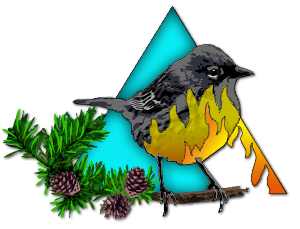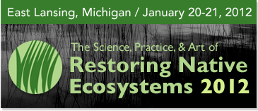Navigation

Upcoming Events
Mar 15: WEBINAR - A synthesis of fire and oak
April 19: WEBINAR - Making sense of wildland smoke
Newsletter Archive
2012 Stewardship Network Conference

At the 2012 Stewardship Network Conference - Science, Practice, and Art of Restoring Native Ecosystems, the Lake States FSC organized a series of presentations and workshops focused on fire science and management. While not recorded, some of the invited presenters have provided copies of their presentations. These are listed below.
Fuel and Fire Behaviour Characteristics in Southern Ontario's Tallgrass Prairie - Mike Wotton, Canadian Forest Service
The University of Toronto's Faculty of Forestry recently developed a partnership with the Canadian Forest Service to increase research focus in Canada on the physical side of fire. As part of that program, several studies of fire behaviour characteristics in the southern Ontario tallgrass prairie have been carried out. The goal of these studies was to quantify important physical characteristics the tallgrass fuel complex (fuel load, structure and moisture content) and fire behaviour (spread rate and flame front properties) and synthesize findings into useful tools for the prescribed fire community. We have developed these findings into a field guide for prescribed burning in Southern Ontario's tallgrass fuel complex. This talk will describe the results of these studies in tallgrass prairie ecosystems as well as present a brief description of the ongoing research in the University of Toronto's physical forest fire science program.
Since 1997, a small population of Cerulean Warblers has been monitored
at Fort Custer Training Center, Kalamazoo County, Michigan. This tract
currently provides 7570 acres of primarily contiguous forest habitat.
In 2011, the focus of monitoring efforts were to study habitat characteristics
of areas utilized by the warbler, and determine resources important during
the breeding cycle for this region. Data was collected through radio-tagging,
observations made while resighting color-bands, nest-monitoring, and timber
cruise surveys at nest locations. Benefits to this species by prescription
fire include: promotion of forest ecotones where resources from burned/unburned
areas coincide to provide increased species richness, promotion of Summer
Grape - a valuable nest resource, increased complexity of forest structure,
creation of snags and top-kill trees within the forest matrix - providing
singing perches as well as dead wood for saprophytic fungus - a nest resource
to grow.
Smoke from prescribed fires, which often are conducted in the wildland-urban-interface, can linger in an area for relatively long periods of time and degrade air quality in surrounding communities. Improved tools that quantitatively predict the potential impacts of smoke are necessary to maximize the benefits of prescribed fires and balance the conflicting needs of ecological fire use and effective smoke management. In response to this need, scientists in the USDA Forest Service are collaborating with researchers at Michigan State University and Ohio State University on a U.S. Joint Fire Science Program project to develop and validate new predictive tools for local smoke transport during low-intensity prescribed fires in forested environments. This presentation provides an overview of the model development efforts to date and a summary of extensive meteorological and air quality observations made during a prescribed burn experiment conducted in the New Jersey Pine Barrens.
Forest managers are increasingly focused on using natural disturbance
regimes as a model for management, and the incorporation of these ideas
is the basis of the ecological forestry approach. Integral to this approach
is an understanding of the importance of biological legacies, stand development
processes and disturbances, and an appreciation for the role that recovery
periods between disturbances play in successional dynamics. While the
approach is being successfully applied in conifer forests of the Lake
States, it holds promise for many of the mixed pine-oak forests of the
region as well. An important aspect of applying this approach is the role
of fire in driving ecosystem dynamics in mixed pine-oak forests. We will
explore the application of an ecological forestry approach to these forests,
with a specific emphasis on the principles of ecological forestry and
possible silvicultural practices (including prescribed fire) that may
enhance biological legacies and stand development processes.
To guide land management within the National Wildlife Refuge System, the 1997 Refuge Improvement Act stipulated that managers should, "where appropriate, restore and enhance healthy populations of fish, wildlife, and plants…." Along with the Biological Integrity Policy (2001), land managers are encouraged to favor ecologically-based wildlife habitat management, with restoration to historic conditions where and when possible. Moreover, because ecological patterns and processes cross ownership boundaries, refuges have been encouraged to work with others in Landscape Conservation Cooperatives to meet broader conservation and restoration goals and objectives. We provide examples of the ongoing research and management partnerships involving Seney National Wildlife Refuge, The Ohio State University, Wayne State University, and Michigan Technological University. Specifically, we illustrate how understanding the needs and capabilities of different institutions has led to conservation and restoration actions guided by applied research focusing on fire ecology and management, forest restoration, wetland restoration, and invasive plant management.
Public land managers require methods for partnering with tribes and incorporating
tribal priorities into their management efforts. We used semi-structured
interviews to document the resource priorities of tribal members in the
Eastern Upper Peninsula of Michigan. Tribal and University partners were
invited to participate in the development of a 5-year vegetation plant
for the Eastern District of the Hiawatha National Forest. Our interview
results will be put into action via this planning process. We are also
organizing a cooperative prescribed burn in a relatively open, mixed oak-pine
stand to promote optimal habitat for culturally significant species. Pre-
and post- burn vegetative and wildlife assessments will be designed and
implemented cooperatively. We are also documenting the fire history of
the site to help frame future fire management decisions. The procedural,
social and ecological outcomes of this cooperative process will be of
interest to public and tribal resource managers across the country.
Workshop: Ignition Planning and Adjustments in the Field - Randy McKenzie,
Michigan Department of Natural Resources; Gary Lindsay, Seney National
Wildlife Refuge; Steve Cross, Michigan Department of Natural Resources;
Benjamin Eby, Huron-Manistee National Forest, Huron Shores Ranger District;
Jack McGowan-Stinski, Cardno JFNew
Many smaller burn units with light fuels can be burned quickly and effectively with few decisions or adjustments. But as the size of the burn unit increases, the fuels or objectives become more complex, or there are critical constraints that must be met, effective initial ignition planning and anticipation of necessary adjustments while in progress require decisions and communications to those carrying the torches. This workshop will provide participants with a simulated experience at sand table scenarios refereed by experienced burn bosses and ignition specialists. Up to 4 unique scenarios will be explored for ½ hour so that small groups of participants can rotate through, maximizing the experience. Our intent will be to prompt for a few decisions and description, but follow with interaction about the issues and the choices in response.
As smart phones make into more and more people's pockets their usefulness expands, even in the great outdoors. This session will outline a number of smart phone apps that relate to natural resources. Highlights include fire modeling and fireline reference apps. Some features will be discussed and demonstrated. Only apps that are available to both iPhones and Android style phones will be covered. Several built in tools can be helpful. Also, given the web navigation limitations of these handheld devices, favoriting of key weblinks can make them even more useful. Some of these sites will be identified and users will be assisted in saving them. Of course, all technology has limits, and several key limitations will be discussed.
Workshop: Can I Really Burn My Own Prairie and Woods? How to Have Successful
Private Landowner Burns - David Mindell, PlantWise, LLC; Glen King. YMCA
Storer Camps
Do you wonder what's involved in burning on private land? How do you get
the proper permits? What habitat can you burn and what areas not? Are
there different considerations for urban vs. rural burns? This workshop
will feature reflections from a private landowner and a "how to"
perspective from a prescribed burn contractor.
Making fire management decisions require a thorough understanding of
the fuel conditions in the area of concern and ready access to weather
forecast and outlook influences on burning conditions. Workshop participants
should plan to bring a laptop or tablet and access the internet. They
will be introduced primarily to two websites with a wealth of information
for the Lake States. The National Weather Service (NWS) Fire Weather Page
(http://www.weather.gov/fire)
and the Great Lakes Fire & Fuels site (http://glffc.utah.edu)
provide access to accumulated historic information and contextual forecast
products to support decisions in the office and at the fire scene.

.png)